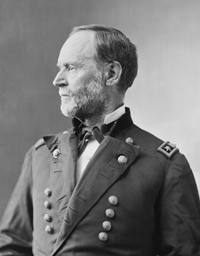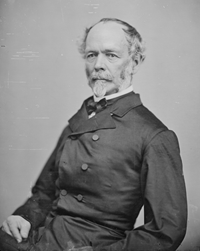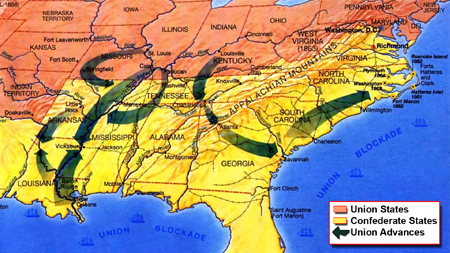


Union General
William T. Sherman
Appointed as head of the Military Division of the Mississippi, which entailed command of Union troops in the Western Theater of the war. He proceeded to Atlanta with the Army of the Cumberland 60,000, Army of the Tennesee 25,000 and the Army of the Ohio (13,000) .

Confederate General
Joseph P. Johnston
After being relived of command by Confederate President Jefferson Davis in July 17, 1864 after losing the Atlanta Campaign. Davis restored Johnston to active duty on February 25, 1865. His new command comprised of the Departments of South Carolina (6,600), Georgia and Florida (12,000), North Carolina (6,000) and later Southern Virginia.
Sherman's Army and the Carolina Campaign
The Carolinas Campaign was the final campaign in the Western Theater of the American Civil War. In January 1865, Union Maj. Gen. William Tecumseh Sherman began advancing north from Savannah, Georgia, towards South Carolina, with the intention of linking up with Union forces in Virginia.
After Sherman captured Savannah, the culmination of his march to the sea, he was ordered by Union Army general-in-chief Lt. Gen. Ulysses S. Grant to embark his army on ships to reinforce the Army of the Potomac and the Army of the James in Virginia, where Grant was bogged down in the Siege of Petersburg against Confederate General Robert E. Lee. Sherman had bigger things in mind. He predicted on January 5, 1865: "I do think that in the several grand epochs of this war, my name will have a prominent part." He persuaded Grant that he should march north through the Carolinas instead, destroying everything of military value along the way, similar to his march to the sea through Georgia. Sherman was particularly interested in targeting South Carolina, the first state to secede from the Union, for the effect it would have on Southern morale.
Sherman's army commenced toward Columbia, South Carolina, in late January 1865. His plan was to bypass the minor Confederate troop concentrations at Augusta, GA, and Charleston, SC, and reach Goldsboro, NC, by March 15. As with his Georgia operations, Sherman marched his armies in multiple directions simultaneously, confusing the scattered Confederate defenders as to his first true objective, this was the state capital of Columbia. His 60,079 men were divided into three wings: the Army of the Tennessee, under Maj. Gen. Howard, the Army of the Ohio under Maj. Gen. Schofield, and two corps, the XIV and XX, under Maj. Gen. Slocum, which was later formally, designated the Army of Georgia. Reinforcements arrived regularly during his march north, and by April 1 he commanded 88,948 men.

The Confederates and South Carolina
Sherman's opponents on the Confederate side had considerably fewer men. The primary force in the Carolinas was the battered Army of Tennessee, again under the command of General Joseph E. Johnston (who had been relieved of duty by Confederate President Jefferson Davis during the Atlanta Campaign against Sherman). His strength was recorded in mid-March at 9,513 and 15,188 by mid-April. The army was organized into three corps, commanded by Lt. Gen. Hardee, Lt. Gen. Stewart, and Lt. Gen. Lee. Also in the Carolinas were cavalry forces from the division of Maj. Gen. Hampton and a small number in Wilmington under Gen. Braxton Bragg.